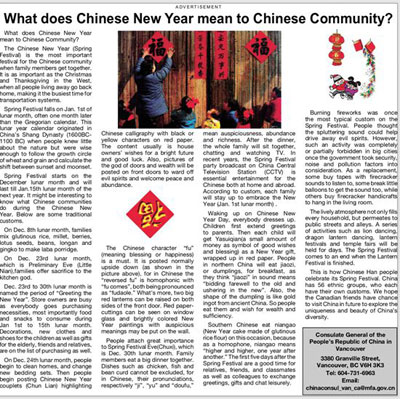On Feb. 13, "Vancouver Sun" and "The Province" published an article written by Chinese Consul General TONG Xiaoling, entitled What Does the Chinese New Year Mean to the Chinese Community, to introduce the origin of the Chinese New Year and the traditional customs, send new year greetings to British Columbia [l1] and Yukon People and welcome Canadian friends to visit China experiencing its diversity. Here is the full text:

The Chinese New Year (Spring Festival) is the most important festival for the Chinese community when family members get together. It is as important as the Christmas and Thanksgiving in the West, when all people living away go back home, making it the busiest and most challenging time for transportation systems.
Spring Festival falls on Jan. 1st of lunar month, often one month later than the Gregorian calendar. This lunar year calendar originated in China's Shang Dynasty (1600BC-1100 BC) when people knew little about the nature but were wise enough to follow the growth circle of wheat and grain and calculate the shift between sunset and moonset.
Spring Festival starts on the December lunar month and will last till Jan.15th lunar month of the next year. It might be interesting to know what Chinese communities do during the Chinese New Year. Below are some traditional customs.
On Dec. 8th lunar month, families mix glutinous rice, millet, berries, lotus seeds, beans, longan and gingko to make laba porridge.
On Dec. 23rd lunar month, which is Preliminary Eve(Little Nian),families offer sacrifice to the kitchen god.
Dec. 23rd to 30th lunar month is named the period of "Greeting the New Year". Store owners are busy as everybody goes purchasing necessities, most importantly food and snacks to consume during Jan 1st to 15th lunar month. Decorations, new clothes and shoes for the children as well as gifts for the elderly, friends and relatives, are on the list of purchasing as well.
On Dec. 24th lunar month, people begin to clean homes, and change new bedding sets. Then people begin posting Chinese New Year couplets(Chun Lian)highlighting Chinese calligraphy with black or yellow characters on red paper. The content usually is house owners' wishes for a bright future and good luck. Also, pictures of the god of doors and wealth will be posted on front doors to ward off evil spirits and welcome peace and abundance.
The Chinese character "fu" (meaning blessing or happiness) is a must. It is posted normally upside down, for in Chinese the "reversed fu" is homophonic with "fu comes", both being pronounced as "fudaole." What's more, two big red lanterns can be raised on both sides of the front door. Red paper-cuttings can be seen on window glass and brightly colored New Year paintings with auspicious meanings may be put on the wall.
People attach great importance to Spring Festival Eve(Chuxi), which is Dec. 30th lunar month. Family members eat a big dinner together. Dishes such as chicken, fish and bean curd cannot be excluded, for in Chinese, their pronunciations, respectively "ji", "yu" and "doufu," mean auspiciousness, abundance and richness. After the dinner, the whole family will sit together, chatting and watching TV. In recent years, the Spring Festival party broadcast on China Central Television Station (CCTV) is essential entertainment for the Chinese both at home and abroad. According to custom, each family will stay up to embrace the New Year(Jan. 1st lunar month) .
Waking up on Chinese New Year Day, everybody dresses up. Children first extend greetings to parents. Then each child will get Yasuiqian(a small amount of money as symbol of good wishes and blessing) as a New Year gift, wrapped up in red paper. People in northern China will eat jiaozi, or dumplings, for breakfast, as they think "jiaozi" in sound means "bidding farewell to the old and ushering in the new". Also, the shape of the dumpling is like gold ingot from ancient China. So people eat them and wish for wealth and sufficiency.
Southern Chinese eat niangao(New Year cake made of glutinous rice flour) on this occasion, because as a homophone, niangao means "higher and higher, one year after another." The first five days after the Spring Festival are a good time for relatives, friends, and classmates as well as colleagues to exchange greetings, gifts and chat leisurely.
Burning firecrackers was once the most typical custom on the Spring Festival. People thought the spluttering sound could help drive away evil spirits. However, such an activity was completely or partially forbidden in big cities once the government took security, noise and pollution factors into consideration. As a replacement, some buy tapes with firecracker sounds to listen to, some break little balloons to get the sound too, while others buy firecracker handicrafts to hang in the living room.
The lively atmosphere not only fills every household, but permeates to public streets and alleys. A series of activities such as lion dancing, dragon lantern dancing, lantern festivals and temple fairs will be held for days. The Spring Festival comes to an end when the Lantern Festival is finished.
This is how Chinese Han ethnicity people celebrate its Spring Festival. China has 56 ethnic groups, who each have their own customs. We hope the Canadian friends have chance to visit China in future to explore the uniqueness and beauty of China's diversity.
[l1]
